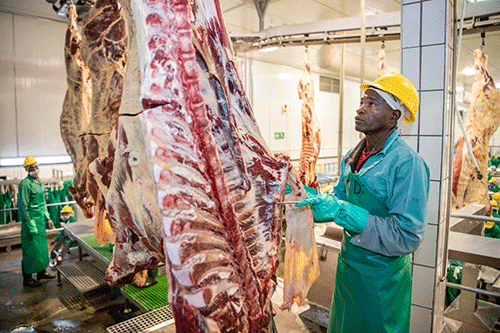Ageing infrastructure, shortage of quality supplies and the growing effects of climate change remain amongst Meatco’s biggest stumbling blocks in becoming one of the continent’s leading meat-processing and marketing agencies.
In its latest annual integrated report, which covers activities of the 2022/23 financial year, Namibia’s prime meat-processing entity highlighted its key pre-determined risk tolerance parameters, which urgently need to be addressed to avoid business discontinuity.
Chief amongst the many problems the State-owned enterprise faces is the issue of ageing infrastructure, such as the Windhoek abattoir, which was originally constructed in the 60s and remains one of the country’s biggest abattoirs that meet international standards.
Although it is well-equipped and properly-resourced to meet international certifications of its various products, the Windhoek abattoir continues to battle perennial power outages and temperature issues to its storage facilities.
The report specifically pointed to the increasing incidence of mechanical breakdowns and catastrophic failures of major components, which affects the future suitability of facilities in terms of technical specifications and efficiencies.
But Meatco is working on rectifying and upgrading its various production processes and systems to smoothen its business operations, the report further indicated.
A preventative maintenance plan, limited inventory of critical spare parts and stand-by equipment, maintenance audits and sorting out equipment that becomes unreliable and too expensive to maintain are some of the key mitigative measures Meatco plans to introduce.
“Annual inspection on all pressure vessels, transformers and substations by high tension service providers; developing a five-year capital replacement plan; introducing international best practices benchmark; building reserves and a five-year strategic plan, where capex is planned and budgeted for to fund critical relocations when it becomes inevitable and the scalability of plant activities to match supply” are additional measures outlined in the report to remedy the situation.
Climate challenges
Touching on the environmental and climate change challenges, the beef-processing entity reported that the ongoing drought has affected its supply chains at its various abattoirs.
However, it has drafted some alleviatory plans to overcome the challenges posed by the ongoing drought and the ever-changing climate patterns.
Meatco plans to introduce a merit point system to effectively manage the high flow rate of cattle to Meatco arising from national droughts, and to ensure new producers do not gain an advantage over existing loyal producers in times of emergency marketing.
“Meatco has feeder contracts with producers to ensure that the pre-determined quality cattle will be received at the abattoir – even during the drought periods. Many of the feeders had their own on-farm capacity to produce their own fodder under irrigation systems,. Thus, they do not depend on rain as the primary catalyst to produce sufficient fodder year-on-year.
“Meatco plans to provide producers with long-term slaughter contracts to ease the planning of both abattoir and producer, and activate the agriculture extension department to enhance producer capacity to plan and serve during the drought periods,” the report added.
To address insufficient volumes, livestock procurement has put the following strategies in place, which are to focus on securing a minimum number of cattle monthly per contract from producers throughout Namibia – both communal and commercial.
They should have sufficient capacity and capability to produce quality-driven, market-ready cattle from privately-owned feedlots and backgrounding facilities.
Feeders’ contracts for large and small feeders have a built-in quality requirement per grade. At farmers’ liaison meetings, Meatco aims to provide formal industry-related training to farmers to enhance the quality of the animals.
Another plan is to procure cattle from Botswana.
The report indicates that Meatco has worked to open a marketing stream from there for slaughtering cattle coming directly from communal and commercial producers in the green zone of Botswana to the Meatco abattoir.
The Namibian context
In the global context, Namibia’s red meat industry is equivalent to the proverbial grain of sand in the desert.
The 1.2 million cattle in Namibia’s herd represents less than a quarter per cent of the global herd, which amounted to 1 billion in 2022.
The production of beef worldwide is estimated to amount to 59 million tonnes in 2022, compared with Meatco’s 8 588 tonnes of meat processed in 2022/23.
Due to Namibia’s nominal share of global beef production, it is imperative for Meatco to focus on selected niche and premium markets for its high-quality products.
Even though agriculture’s contribution to the Namibian GDP (excluding the fishing sector) over the last five years has been just under 4%, it remains one of Namibia’s most important sectors, as the majority of Namibia’s population is dependent directly or indirectly on the agricultural sector for their livelihoods.
Livestock farming contributes to approximately two-thirds of Namibia’s annual agricultural production, with crop farming and forestry making up the remaining one-third (excluding the fishing sector). Worth N$6.3 billion, Namibia’s livestock farming sector is in dire need of growth. Growth starts at the farm level, but will only happen when it is profitable for producers.
Only conducive policies and a constructive regulatory environment, as well as a common vision for the Namibian red meat industry, will enable substantial growth to take place in the Namibian livestock farming industry.
-ohembapu@nepc.com.na


